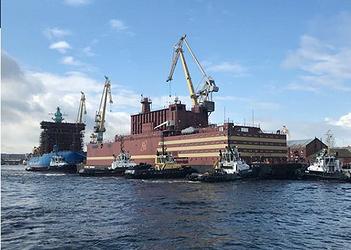
ST. PETERSBURG, Russia, April 30, 2018 (ENS) – The world’s only floating nuclear power unit, the Academik Lomonosov, Saturday left St. Petersburg, where it has been under construction since 2009, and headed to its base in Chukotka, Asia’s easternmost peninsula in the Russian Far East.
The initial plan was to load the floating power plant with nuclear fuel and test it in St. Petersburg.
But due to pressure from the Baltic states and a petition organized by Greenpeace Russia, Rosatom, the state nuclear corporation that owns and operates the Academik Lomonosov, decided last July to move the fuel loading and testing to Murmansk, a smaller city located above the Arctic Circle.

“To test a nuclear reactor in a densely populated area like the center of St. Petersburg is irresponsible to say the least. However, moving the testing of this nuclear Titanic away from the public eye will not make it less so,” said Jan Haverkamp, nuclear expert for Greenpeace Central and Eastern Europe.
“Nuclear reactors bobbing around the Arctic Ocean will pose a shockingly obvious threat to a fragile environment which is already under enormous pressure from climate change,” he said.
The floating nuclear power unit, FPU, now will be towed to Russia’s northernmost town of Pevek in two stages – around Scandinavia from St. Petersburg to Murmansk through Estonian, Danish, Swedish and Norwegian waters, and then along the continent’s northern coast from Murmansk to Pevek.
“At the first stage, the FPU with no nuclear fuel on board will be towed from the territory of Baltiyskiy Zavod to the landing of Atomflot FSUE in Murmansk. Then, at the second stage – roughly in the summer of 2019 – it will be sent from Murmansk to the seaport of Pevek, loaded with nuclear fuel and with the crew on board,” says Dmitriy Alekseenko, deputy head of the Directorate for the Floating NPP Construction and Operation.
According to Vitaliy Trutnev, who heads the Directorate for the Floating NPP Construction and Operation, “To date, a part of the work provided for by the contract with Baltiyskiy Zavod Shipbuilding has been successfully completed. At the next stage, which will be carried out on the territory of Atomflot FSUE in Murmansk, we have to solve the following important task – to prepare the facility for taking nuclear fuel on board.”
The floating power unit will be hauled along the St. Petersburg-Murmansk-Pevek route by the Marine Rescue Service of Rosmorrechflot, the Federal Agency for Maritime and River Transport of Russia at a speed of approximately 3.5 to 4.5 knots.
All construction works to create on-shore infrastructure are underway in Pevek. The pier, hydraulic engineering structures, and structures for the mooring of the FPU and operation of the floating nuclear power plant will be ready to use upon the arrival of the Akademik Lomonosov in 2019.
In Murmansk, a “solemn ceremony held with the participation of the media and the public” is planned, Russian officials say.
The nuclear fuel will be loaded into the reactor and it will be physically started up in Murmansk this autumn. The ready-for-operation FPU will be delivered along the Northern Sea Route to the work site, unloaded at the mooring berth, and connected to the coastal infrastructure in Pevek.
After the FNPP is operational, sometime in 2019, it will replace the Bilibino nuclear power plant and Chaunskaya TPP that are technologically outdated, and will become the most northerly nuclear power plant in the world.
The floating nuclear power unit has two KLT-40S reactor units that can generate up to 70 MW of electric energy and 50 Gcal/hr of heat energy during its normal operation. This is enough to power a town of 100,000 people, Russian officials say.
Its main task will be to provide electricity to remote industrial plants and port cities, as well as offshore gas and oil platforms.
Russian officials say the floating nuclear plant is designed with a “great margin of safety that exceeds all possible threats and makes nuclear reactors invincible for tsunamis and other natural disasters.”
In addition, the nuclear processes at the floating power unit meet all requirements of the International Atomic Energy Agency and do not pose any threat to the environment.
But environmentalists are not so sure.
“The floating nuclear power plants will typically be put to use near coastlines and shallow water. Contrary to claims regarding safety, the flat-bottomed hull and the floating nuclear power plant’s lack of self-propulsion makes it particularly vulnerable to tsunamis and cyclones,” said Haverkamp.
According to Russian media, Rosatom is planning a production line capable of mass producing floating nuclear reactors. Construction of a second floating nuclear plant is expected to begin in 2019.
Backed by its owner, the Russian government, Rosatom has been in talks with potential buyers or lessees of these floating reactors in Africa, Latin America and Southeast Asia.
“This hazardous venture is not just a threat to the Arctic, but, potentially, to other densely populated or vulnerable natural regions too,” said Haverkamp.
There are indications that 15 countries, including China, Algeria, Indonesia, Malaysia and Argentina, have shown an interest in hiring floating nuclear plants.
Copyright Environment News Service (ENS) 2018. All rights reserved.
© 2018, Environment News Service. All rights reserved. Content may be quoted only with proper attribution and a direct link to the original article. Full reproduction is prohibited.
